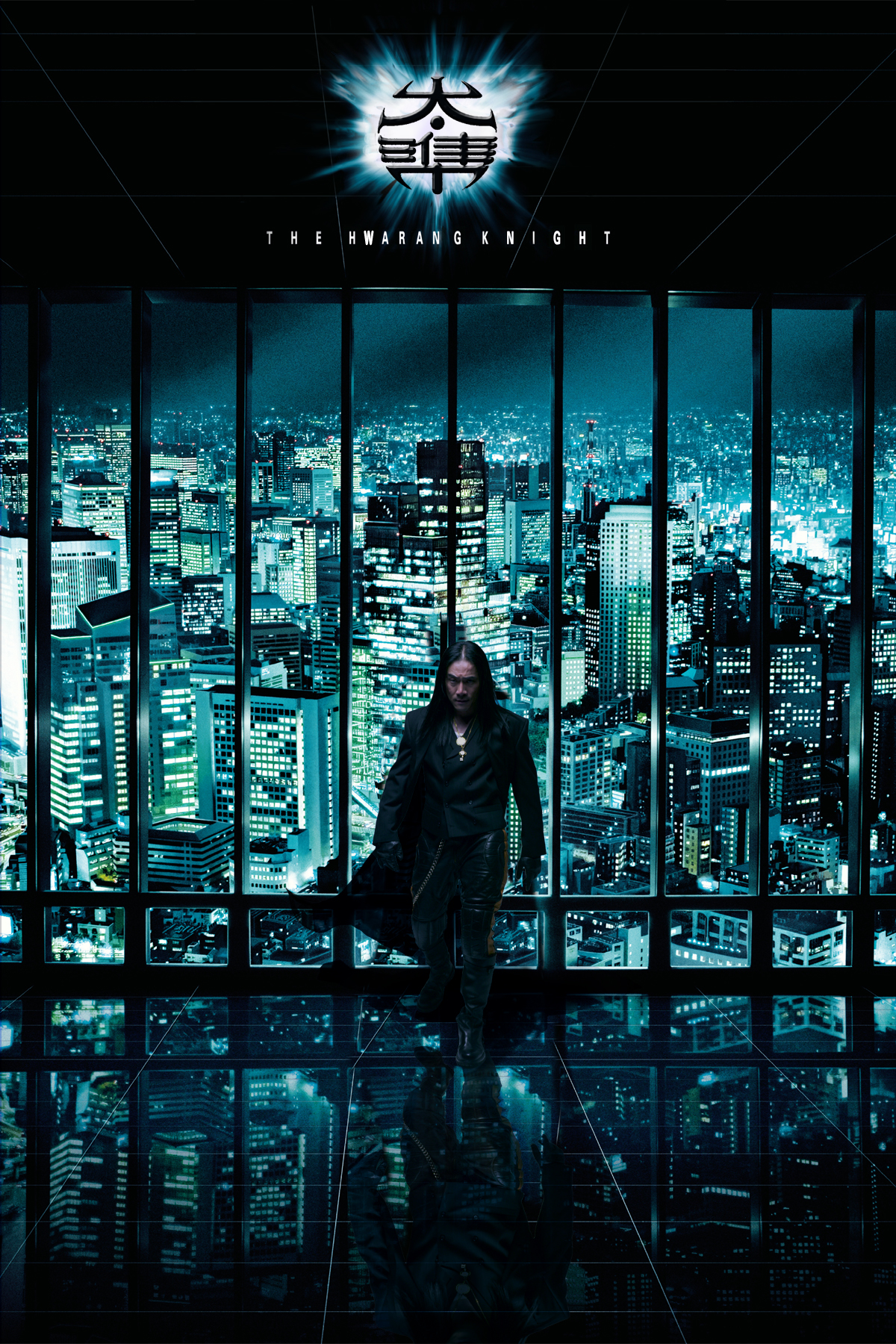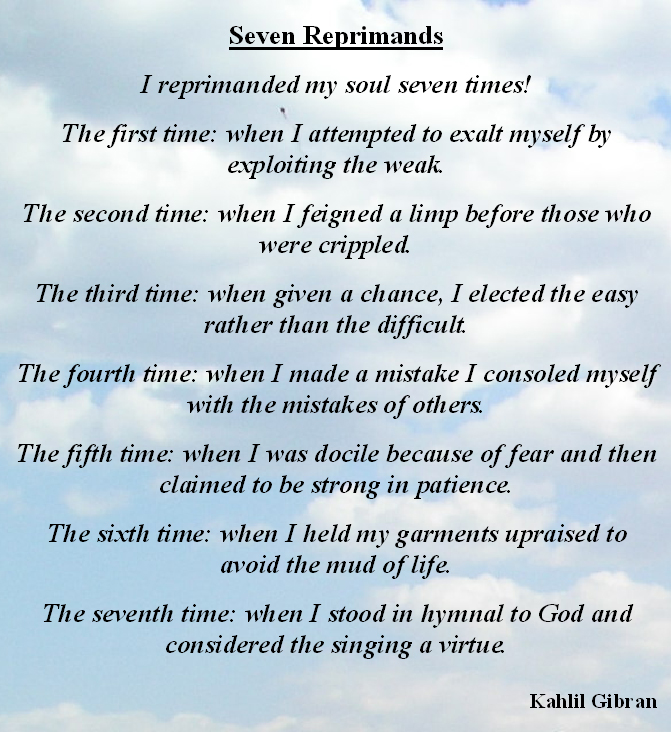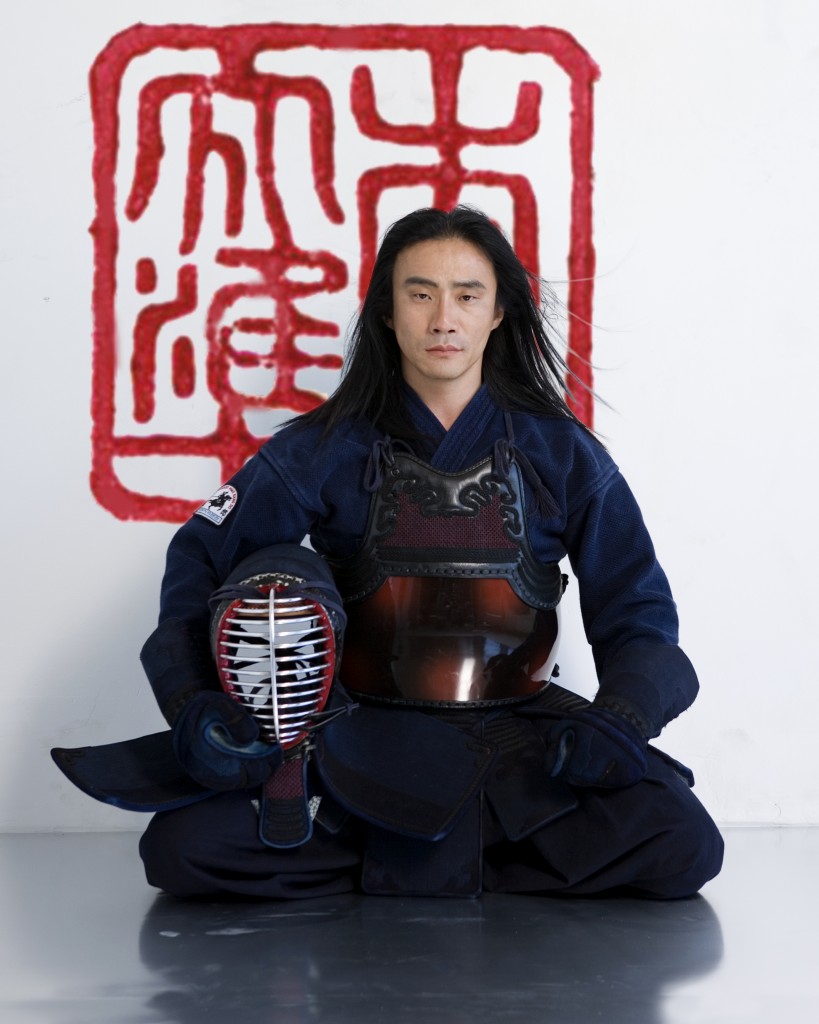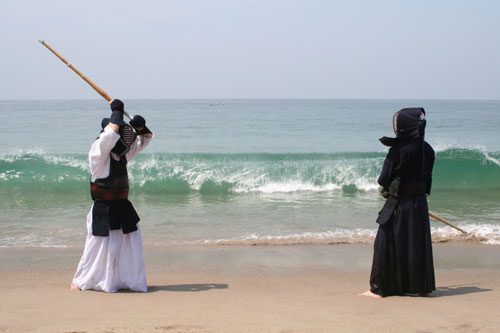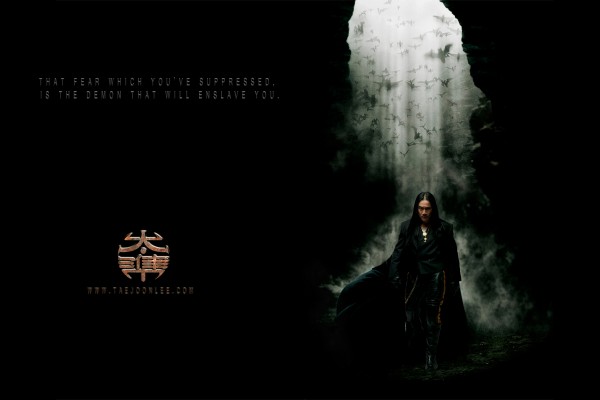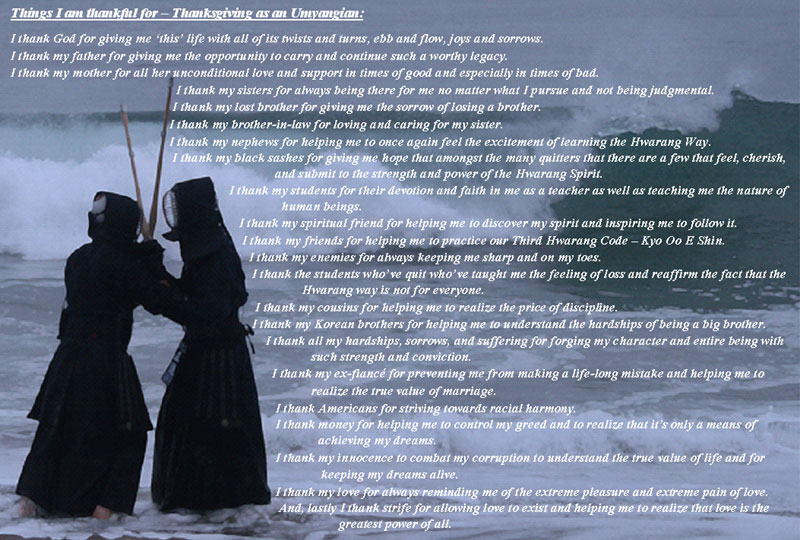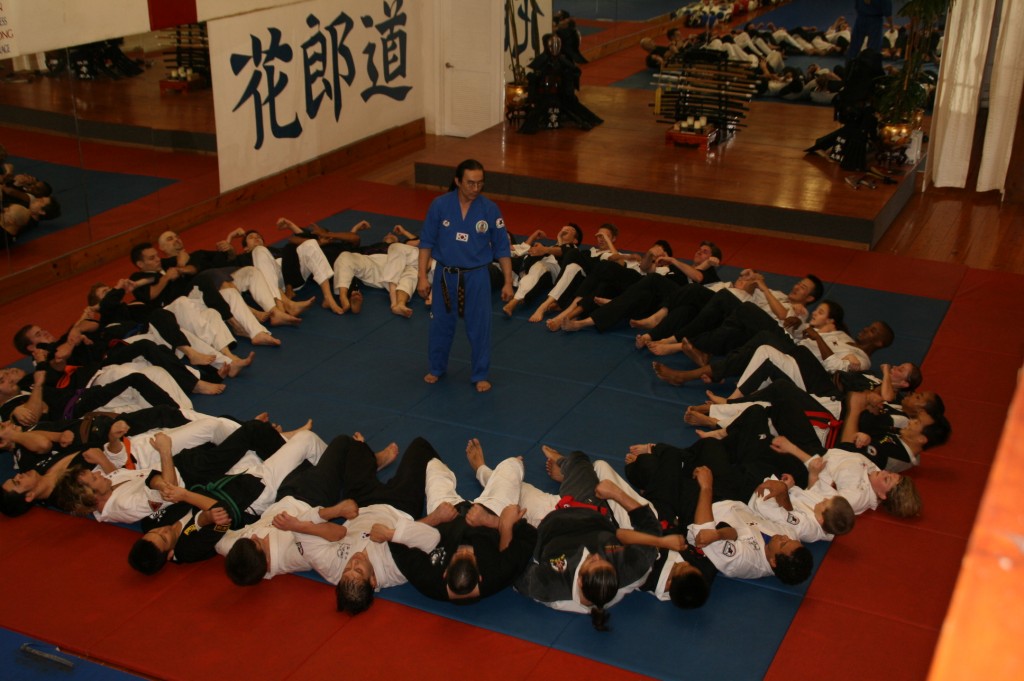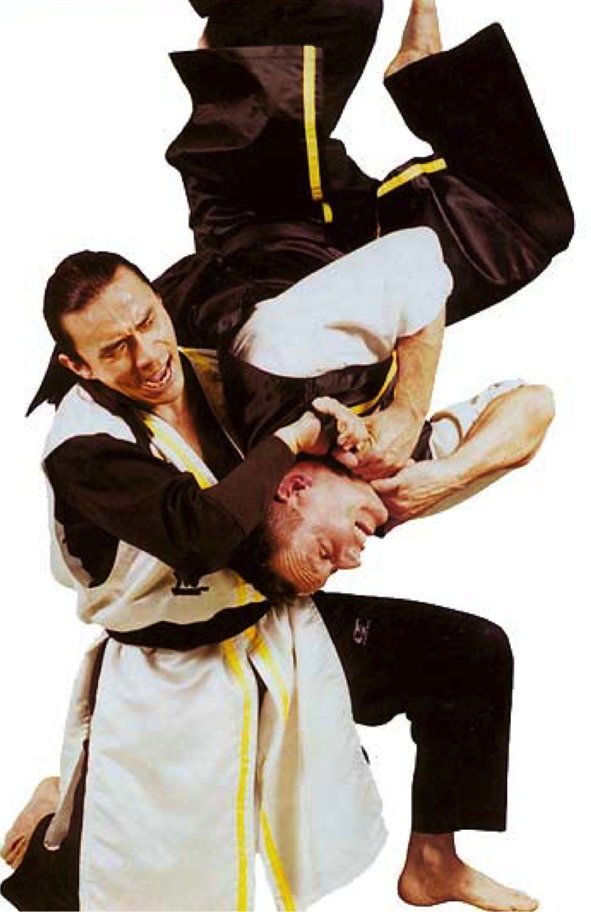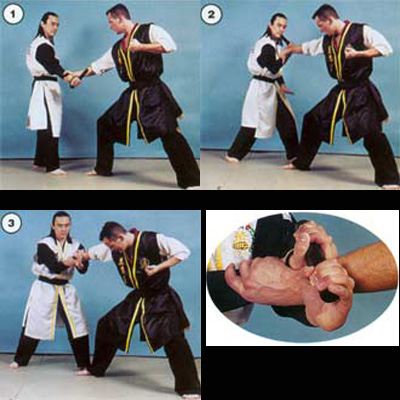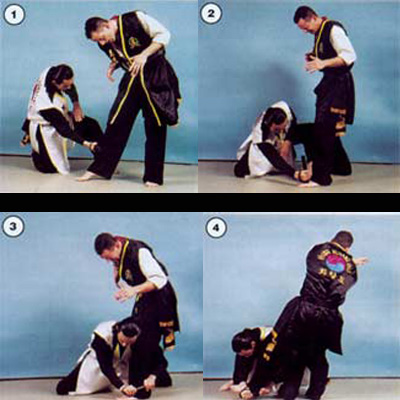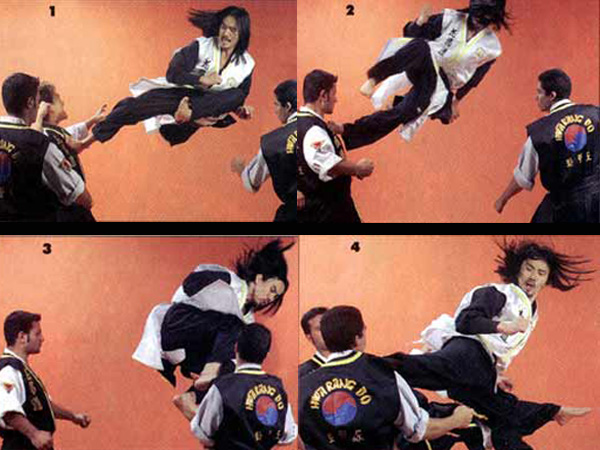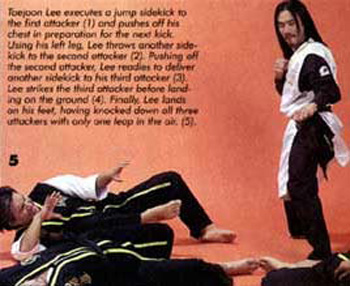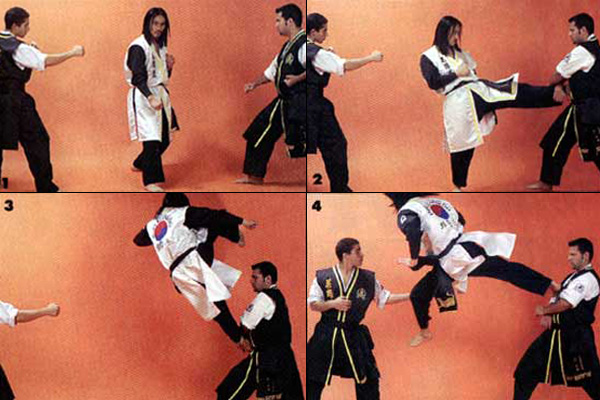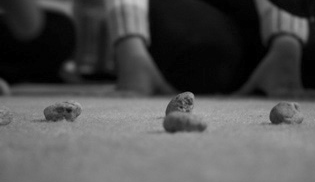
Each month the Teuk Gong Team (TGT), our instructors and assistant instructors, gather for dinner to share ideas and develop greater bonds. In February, Antonio Goodwin hosted the dinner at his home in Ladera Heights. The adults were in the living room, conversing about our school and students, while the juniors ranging from 7years old to 11 were in Dominic’s room, Antonio’s son.
After a short while I decided to go check on the children and what I saw was truly the sign of our times. There were five kids in total and each was doing their own thing: reading a book, playing on a Gameboy, watching a movie on a portable DVD player, playing with an iphone, etc. None of them were speaking, playing, or engaged with each other.
I could not believe what I saw. I had to do something. I said, “What are you guys doing? Put that stuff down and follow me.” I proceeded to walk outside as the kids followed, puzzled and somewhat reluctant. I walked over to a small patch of dirt field (which was not easy to find) and went hunting for rocks. I found one that was the size of a marble and raised it up, “I want you guys to find rocks about this size.” The kids were even more puzzled, but soon they were laughing and excited to find a rock that fit the profile.
“Master Lee, like this one? Is this it?” Each one of them came over to show me what they’d found. After collecting a handful of rocks, I picked the best ones and we all went inside. I had them all sit in a circle and I taught them Korean jacks, “Gong-gi.” It’s similar to American Jacks, but a bit more difficult, requiring greater hand/eye coordination. After I demonstrated what needed to be done and how to keep score, I had each of them try. It took some effort, but soon they were getting the hang of it. They were having a blast, laughing, talking – engaged in each other’s performance. I belted, “This is playing. Keep it up and if you have any questions, come get me.” With that, I went back into the living room.
In the living room, I found some of the adults on their laptops, surfing the web, checking email, etc.
The laughter and the excitement continued to escalate in Dominic’s room and it soon overwhelmed the chatter in the living room. Some of them came back out to notify me that they passed another level with intense excitement in their voices. I was very delighted, yet perplexed what our children are becoming and where our society is heading.
Technology is supposed to make our lives easier and better by providing faster and more efficient means of doing our work, giving us more time for the real valuable things in our lives like family, relationships, and self-development, right? I mean that is what’s promised to us: faster, easier, better.
Then, if they have so much more time to do other things, why can’t my students maintain regular attendance of only twice per week? 20 years ago, students attended a minimum of three Hwa Rang Do classes (there was no Tae Soo Do) per week and most came every day. We had classes daily for both children and adults. Ah, but now they are doing things that are more meaningful – like what I ask you? Do they have more enriching relationships? Do they maintain greater familial bonds? Have they acquired higher consciousness?
In Korea there is a contest to see how fast people can text messages. There’s also an epidemic of children not knowing how to spell words properly because everything is shortened and abbreviated. I think that’s the same here. I have students working in corporate America who spend most of their time at work online – chatting, social networking, surfing the web – that has nothing to do with their work, but they still get paid the same or more. They are finishing their tasks sooner due to technology, so they have more time, but is that time being used for something meaningful? They spend it being distracted, because thanks to the same technology, being distracted is now that much easier and that much more interesting. Instead of twiddling their thumbs or spinning their pens, they spend their spare time on YouTube, Facebook, MySpace, Twitter, etc. We must reconsider, rethink, and reorganize how we manage our workforce, and how we are spending our lives.
A while back Yahoo Magazine did a comparison between using the Internet or the Yellowpages for finding items for purchase. Almost at every instance the Yellowpages was faster, but now the Yellowpages has become a dinosaur. When you are searching online, there are so many other distractions that you might have intended on buying some table settings and come out having bought a car.
With all of our advancements in technology we cannot seem to create anything that lasts. The History Channel recently aired a documentary answering the question of what the world would be like after human beings. One of the things that stood out for me is that the world’s ecosystem would be fine without any human beings and that in a matter of 500 to 1,000 years, all records of our existence would have been erased completely from the face of the earth, except for some ancient monuments like the Pyramids of Egypt or the Stonehenge.
Do you not think that with our technology we cannot come up with anything that lasts more than a few years or find a cure for cancer, AIDS? Even if we could, do you think we would?
Everything is fast and quick and replaceable with upgrades – new and improved is the motto. Just recently I lost a phone charger and went to Best Buy, the all-in-one electronic store which is shutting down all its competition. They had all kinds of chargers but nothing worked for my phone. Finally, the salesman after digging through stacks of boxes found one that would work. I belted, “Why couldn’t they just have one adaptor that fits all?” Of course I knew the answer, but I needed to vent.
The salesman replied, “They couldn’t make money that way.” It irritates me that the newly released movies come out on dvd format first, a few days before the Blue-Ray. A couple of times I was suckered into it and bought the dvd because I could not find the Blue-Ray. I do not watch TV, and only see films of my choice. After I purchased the dvd, the next week I went in, and behold, I saw it on Blue-Ray. Now I own the VHS tape, the dvd, the high HD version, the Blue-Ray disc, and let’s not forget the extended version, the unrated version, and the director’s cut. I wonder what other versions they’re going to come out with next? Recycling the same content over and over again in different formats, newer, improved, faster, smaller, and I am just as guilty as any other consumer, but of course nothing lasts. One of my students who is in marketing told me that there is actually a term for this. It’s called “Chaos Marketing.”
Back in the 80s when the pager was the thing, I remember how I hated seeing these guys in suits with two and three pagers on their belts, accompanied by a key chain that would out do any janitor (definitely overcompensation for some other deficit). Then it moved to hand phones and now the same is true.
I really don’t get too many calls on my hand phone. Just from my immediate family and in case of emergencies. Recently, I was very ill and couldn’t think straight and lost my phone for the first time. I am the guy that had the first cell phone (not hand phone because there’s no way to fit it in one hand) that was the size of a small brief case. For about three days I was completely lost and all day in the back of my mind, I was thinking about my phone. It consumed me. Finally, I found my phone in my bathrobe pocket. I checked what messages and texts I missed and there were only a few and nothing that was earth shattering. I felt so relieved, whole again. I had to sit back and think about this for a bit.
How insane is that?
It’s getting out of control. This type of thinking has infiltrated every part of our lives where each individual thinks of only their own pleasure, their own personal gain, regardless of others. Or if they do care about others and global social events, then they’re too busy, too occupied with following someone else’s life or spending time enhancing their profile and sharing their party pictures with the rest of the world that they have no time for their loved ones, their self development, real social issues, and their spirit. The distractions have become their lives; being constantly connected to the media 24/7 like an umbilical cord connected directly to corporate America, the 1% has constant access to your mind and pockets. It is the Matrix.
I had a student, a graduate of Harvard Law School, who loved gadgetry and technology. He once said that if the world lost power and we had to revert to manual mechanisms that he would come to my dojang. I pride on myself that I am self-reliant and resilient. That is the foundation of Hwa Rang Do’s training, but lately I also have been caught up in this dependency on technology; a physiological, emotional, and psychological dependency that affects my self-being, our society, our humanity. Unbelievable.
So, when I saw those children in a room together, all attached to their own gadgetry and not socializing with each other and playing like kids should, it affected me to my core. And, imagine – only five rocks that cost me nothing brought the greatest joy and unity to these children.
All things, good and bad, are necessary and can be useful. As Hwarang and warrior/scholars we must learn self-control and utilize those things around us as well as all aspects of our ‘self’ to maximize our lives and the lives of others. However, we cannot become dependent. We must be our own masters. At this rate, if the world did run out of power, the Amish would reign and we would once again be dependent on something, someone other than ourselves.
Let’s think for moment: Who does this dependency serve? Who does this advancement in technology really serve? Does it serve us, the people, the common folk? Or, does it serve the wealthy and the powerful? The disbursement of wealth across the globe is getting worse each day as the percentage of the people possessing the majority of the wealth is getting smaller day by day. Big conglomerates, big corporations, multi-billionaires, governments don’t care about common misfortune caused by disasters, war, or other tragedies. To them, every situation is an opportunity for greater economic/territorial gains, and ultimately a means of greater control.
Look at the absurdity of our existence. Water is a natural resource, but they put it in a bottle and sell it and we buy it: For what? The cleanliness and purity? So that we can live longer and healthier? Water is almost 8 times more expensive than gasoline. We pay over $1 for a 16oz bottle of water and there are 128 oz in a gallon and at most we only pay $3 for a gallon of gasoline. Why don’t we just drink tap water? Because we have a collective notion that the water is somehow impure or contaminated. This is not Mexico, and yes I know because I have experienced Montezuma’s revenge. And who created the pollution that contaminated the drinking source in the first place? Of course, it’s the big companies in the pursuit of increasing dividends and governments all in the name of saving tax-payers money. Do you get the picture? They cannot lose. They will continue to make money and take advantage of every opportunity to make more money by continuing to create dependencies and creating new markets, new frontiers to exploit. The real world is not enough so now we have the world wide web and virtual worlds to exploit. What will they do next after they pollute the air to the point where it’s not safe to breathe? They will sell us bottles of filtered air or oxygen of course (this is happening already).
When has faster, quicker, easier been better? The pyramids of Egypt have lasted for 5000 years and will continue for thousands more. In the past, if it did not last and was not durable, then it was not valuable. The martial arts industry has also been impacted by this type of thinking. You cannot build a fortress out of marshmallows. Strength in training, self-discipline and self-reliance are what create strength of mind, body and spirit. There are martial art organizations that market gun and knife disarmament as their primary method of attracting the public for self-defense. And it seems to be working. One of the main keywords in Google search is now ‘Krav Maga,’ – not martial arts, karate, kungfu or even MMA. Yes, they are doing a great job marketing their product. However, what they are selling is something that bears consideration. Even the most experienced martial artists who have consistently trained for decades are reluctant to disarm a weapon in a real scenario. More important than the physical techniques is their ability to maintain calm and think clearly to create opportunity for escape. But, even then it’s risky and only should be attempted as a last resort. A case in point: I was invited to Fort Benning, Ranger School to meet and instruct some of the most elite law enforcement and military personnel from Mexico, Central, and South America. There I had the privilege of having a discussion over dinner with the people in charge of creating and instructing the Army combative for the entire US Army Corp.
They told me a story. The Rangers were performing a military exercise within the small town near the Fort. At the time some of the Rangers were learning a special hand-to-hand combative system created by some Hapkido master. One of the Rangers in the exercise was approached by the town policeman, who at gun-point told the Ranger to drop his weapon, which the Ranger did. Thinking that this was part of the exercise, the Ranger sought this opportunity to practice his handgun disarmament technique on the police officer. Unbeknownst to him, the policeman was not part of the exercise and as the Ranger attempted to disarm, the policeman shot and killed the Ranger. Sure, weapon disarmament is a viable option and there are proper techniques to increase the odds of success. However, learn it easy and quick in a few months or in a seminar, and chances are as the military men say, “you learn just enough to get yourself killed.”
The companies hit a jackpot when we all logged on. In the computer age, it has become a given, an accepted standard, the norm, for things to become out-dated in a matter of six months to a year. Everything must be upgraded. How fantastic is that? It’s a never-ending market of continual consumption – a created dependency and continual supply of new and improved products that will offer greater performance and enjoyment. Sound familiar? This is how drug dealers push the newest drug on the market. Get you hooked and then offer better highs.
And schools are becoming pushers for the pharmaceutical companies. This is another topic for another time, healthcare in the United States. However, I did want to bring attention about what the schools are doing to our children. I laughed when nursery schools were banning musical chairs because it was too competitive. “Why should only one kid win and 20 others lose?” Last time I checked we were a capitalist society and the nature of capitalism is competition. Now, they are not even keeping score playing regular sports like baseball, soccer, basketball, and football. That’s just plain silly and I am not laughing anymore.
The nature of children is attention deficit and hyperactive. They are full of energy and have very little attention span. It is not a disorder, but the norm. Jim Thorpe, a Native American, who was named the greatest athlete of the first half of the twentieth century by the Associated Press and a gold medalist in the pentathlon and decathlon at the 1912 Summer Olympics in Stockholm, Sweden, was challenged to mimic everything that a two year old child did physically for an entire day. The 2 year old won and laid Jim Thorpe out, exhausted. This 2 year old was your average child, not one with a hyperactive disorder. Of course, some kids may need more attention than others, but by no means do children in their formative years have a disorder – they’re just being kids, curious about the world and eager to participate.
So, since technology has helped us to do work in less time, then parents should have more time to spend with their children, their family, hence improving focus, channeling energy and aggression, and enhance both their intrapersonal and interpersonal development, right? Wrong, very wrong. We have become a society of people who feel entitled to everything good life has to offer, without any sense of accountability and self-sacrifice. We blame everything wrong on others and take credit for everything good, however trite and ridiculous it may be.
The schools, the classrooms are overcrowded as government continues to cut funding toward our educational system, which is a short-sightedness that I predict will have dire consequences in the future. But, who cares right, as long as I am living well now, what does it matter? It matters a lot if you feel you are part of humanity, which we all are whether you like it or not, but I guess that’s one of the problems: we are more connected than ever with each other, but we feel less humane. Our sense of community has been diminishing city by city, town by town. In the 3rd and 4th grade, one of my favorite parts of the day was walking over to my friend’s house and walking to school together. Not in a small midwestern town, but in the heart of Los Angeles County – Downey, CA. There’s something awfully wrong when we can’t allow our kids to play in the streets, walk to school, or be out of a parent’s sight and ears for any length of time.
When a child in school has problem focusing on his work, not paying attention, talks too much with others, and forgets what he/she was told to do (all things that all kids do, some more/some less), the teacher sends the potential problem child to get an evaluation. Once the evaluation is complete then the parents are brought in to discuss options and this is how it’s said to the parents, “If your child has problem seeing, would you not get your child glasses to see better?”
“Sure,” the parent replies.
“Well, then by medicating your child, he/she will be better focused, which will increase his/her grades and enhance his/her chances to get into a good college for a better life,” school counselor. What parent would not want to help their child by increasing their chances of doing better in school so that they can get ahead in life? However, this isn’t a pair of glasses. It’s chemicals which are altering the child’s mind from normal development in the most rapidly growing stage of the child’s life. I am not a scientist or an MD so I will not attempt to get into the negative physiological affects of medicating children with mind-altering drugs in their formative years, but what I will address is something that is even more sinister.
I had a female student who has been medicated since elementary school. She is now in her late 30s and she cannot function without the drugs. When posed by me with the hard decision of giving up the drugs and rediscovering herself through hard self-examination and martial discipline, she chose to quit training and continue to take the drugs. This was after 3 grueling years of Tae Soo Do training, and embarking on the Hwa Rang Do way for the rest of her life. What’s more disturbing, she is also medicating her child who’s only 8 years old.
Ah, you say, that she doesn’t fit the timeline. She started taking the drugs in the early 80s. I think that just goes to show how long this has been practiced and how much more rampant it is today. I just had an 18 year old come up to me at my last seminar in Minneapolis in March of this year, saying, “I have been on all types of medication since I was 5 years old and after joining Tae Soo Do, I decided to quit taking the drugs to find out who I really am and see what’s really wrong with me.
Well, it’s been two years now and I have never felt better in my entire life and I am beginning to truly get to know who I am.” All we are doing is creating a pattern of dependency for the rest of lives and once again, who does that really serve?
How can we blame our kids for not being able to learn? That’s all they do, is learn from the world around them and by following, mimicking the actions of others. If a child does not learn or did not learn, then we have failed as parents, as teachers, as a society. I thought that cats were un-teachable. I was proven wrong. Recently, in a variety show, I saw a man who had cats doing what trick dogs do; jumping through hoops, walking on wire, going across parallel bars, all on command. I was blown away. I don’t know if you have ever tried to teach your cat to sit or come on command, but I have. I had both dogs and cats as pets and believe me dogs are far easier to teach than cats. I have never successfully taught a cat to do anything on command, but just let them do what they want, including petting them. So, when I saw this man having all these cats obey him and follow his every command, I realized that it was me and not the cats. So, if he can teach cats, then we can teach our children; don’t you think?
I don’t mean to demean our children or even humanity by comparing them to our pets, but only to illustrate how absurd it is for us to give up on our children and resort to drugging them to be more compliant. These cats were only getting tasty bits of food for reward and no drugs to induce compliance. I remind my students that our greatest weapon, greatest tool is our mind, which is undeniably unique only to the human race and it is this that we must cultivate. Furthermore, the greatest advancements in our culture, society, sciences, arts, and everything in between have been accomplished by people who thought outside the norm, the status-quo, and challenged conventional thinking.
It is not enough that my country of birth, South Korea, has risen from the ashes of war and poverty to one of the economic powerhouses in the world in less than 50 years, which now enjoys the luxury of giving their children plastic surgery as a high school graduation gift, making girls look very similar to each other. You marry a girl because they look so fine and end up having a child that looks nothing like the mother. Of course, I am being facetious, but it’s not far from the truth. Now, in my homeland, the United States of America, we drug our children for compliance; appease the children by removing competitive spirit; appease the masses by submersion in distractions; drug the elderly to keep them around a little longer to medicate them a little longer; and drug the rest of us for being sad or depressed at times, which of course is not acceptable; and lets not forget being “Politically Correct” which in effect is a gag order, preventing anyone from speaking their mind; oh and did I mention that we are a military state where the government can arrest and detain any civilian indefinitely?
I don’t know if the rest of the world is blind or just silent, maybe appeased and drugged already by the media and technology, but the few who are in power and possess the wealth are blocking entry into the club and continue to expand their market at exponential rates, thanks to technology and globalization. Is this a new phenomenon in our human history? Of course not! It has always been here as we continually struggle for power, territory, control and influence. However, the difference now is that due to our technologies, it is easier and faster to globalize and expand for companies and for nations. I am not interested in blaming the people in power or organizations of power for doing what they’re meant to do – survive, thrive, and conquer. I’d be doing the same thing I have been advocating not to do. But, hopefully they will act responsibly and wisely, which I know is a lot to ask.
In self-defense one of the most important things is awareness. To be focused on what’s immediately in front, but being completely aware of your surroundings. That also applies here. I am pleading to the world, to our community, to my students to be informed and aware. Furthermore, in our training we learn that we cannot control anything outside of the self and the only thing we have control over is the self. We learn that we are only as strong as our weakest self. Therefore, we learn to be extremely self-critical, seek out our weaknesses and fears to overcome them, increasing our self-control, then and only then can we help others. As I have said earlier, we are all affected, including me. In the same way we can live life or be victims of life, we also have a choice here. We can choose to self-regulate ourselves and control our addictive nature or we can choose to fall victim to our own ignorance.
I am not advocating complete abstinence. I have never advocated abstinence in anything as I feel that is not the solution – going to one extreme has the tendency to build repressed potential energy to swing to the other extreme. To me, as in Hwa Rang Do and as an umyangian, the answer lies in balance and self-control: being in sync with the rhythm of the internal self and the external world, with the material and the immaterial, with the microcosm and the macrocosm. Then, hopefully we can be in harmony with nature and the universe.
A few months ago, my family purchased a cabin in Big Bear, as one of my passions is snowboarding. Our family, Hwarangdo family, and my nephews spent the weekend for the first time at the cabin. Being a skateboarder during the founding years when skateboarding took off with the invention of polyurethane wheels some thirty plus years ago, I enjoy playing ‘Skate’. One of my instructors, Joey Klein, one visiting black sash, Brett Spoehr, my 9 year old nephew Jeffrey Kim and I played PlayStation3 together until 4am (would have gone longer if I wasn’t going boarding in the morning) and had the best time ever. The game brought together and bonded a group ranging in age from 9 to 40+. How great is that? As a matter of fact, Joey and Brett could not contain themselves and broke out into a contagious laughing fit. Soon, we were all laughing so much our bellies ached the next day and managed to keep our Hwa Rang Do Founder, Dr. Joo Bang Lee, up all night. Even he did not come down and shut us up, as he knew how special it was to have his martial sons and grandchild enjoying each other’s company.
I believe there’s a time and place for everything. It is up to us to utilize all the things life has to offer, all our faculties, all our God given gifts to get the most out of life by doing and experiencing all that we can live a full life.
This is one of the best eras in all of history. We have so much information, knowledge, and technology to unify and join all races, nations, and people of all ethnic backgrounds, offering the means of living a better life than ever before. It is my hope that corporations, conglomerates, and nations utilize their powers to bring greater unity and racial harmony so that we can move forward by expanding our individual and collective consciousness to really live life focused on the important, valuable things – our relationships, humanity, and our relationship with the infinite. Not continually treating the human race as infantile children, controlling us with repressive fear tactics and increasing dependencies, but rather liberating ourselves from the confines and limitations of material goods, base emotions and greed.
This discourse started with my wanting to talk about kids being attached to technological gadgetry rather than being attached to each other, and ended up with me spilling my frustrations with our current society. I am not done and I have much more to say. I hope one day to follow it up with a book. However, I hope this has at least sparked some thought and will motivate you to take action.

With love and compassion and the belief that we can change the world – one person at a time,
Hwarang Forever,
Grandmaster Taejoon Lee
A Humble Servant to Humanity
www.hwarangdo.net
